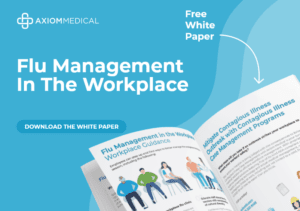[00:01] – Holly Foxworth
Welcome back. We’re at the halfway mark. So we’re at session four of eight in Axiom Medical Fast Track to OSHA COVID Compliance Virtual Summit that we are conducting this morning. Things have been going well I think to this point, we’ve now covered the keynote address, and that was from Dr. David Michaels. We also had the HR legal implications that Chuck covered. And then we just wrapped up with Mark where he was speaking about the ESG. So I am tickled to death to be able to present this next section is going to be with Connor, Connor Trotter. He is one of our supervisors, and he’s in the area of manager there. Connor’s actually in New York at the moment. So I think he probably has a little better than what we have here weather than what we have right here in Texas or where I’m located, but just a quick reminder here. If you have any issues, technical issues while you’re watching, you will notice that at the bottom of your screen, there are several little boxes down there. So if you want to locate the one that looks like a question mark and type in your question, you can use that space to do so.
[01:08] – Holly Foxworth
One other change that’s a little bit different from what we utilize for traditional webinars is the Q & A session. So this time we have what is called breakout rooms, and you’ll notice that looking at a screen at the far top right corner. And so what you will do is you just press that “Join” button and that would take you right there to the breakout room. You can interact face to face with representatives from Axiom. And then after Connor wraps up his presentation, then he will join you there as well for about 30 minutes of a Q & A session. So don’t miss up on that. Even if you don’t have a question, you’re welcome to join just kind of hear what some of the other ones are. But Connor has a great topic that he’s going to be covering. It’s always kind of that big fear that plays in the background, which is what do you do if you have an unannounced OSHA inspection. And the only other thing that I want to mention before I turn it over completely to Connor is that after he is done and we have the Q & A that’s there in the breakout room, you have to register. You have to have a link to be able to access session number five. So if you’re not already registered, don’t worry, there’s a box that will pop up. It’s a prompt, and you will just press that “Register Now” button and it will generate an attendee link for you. So, Connor, I’m going to go ahead and turn it over to you, and you can kind of give some info on what should be expected should OSHA arrive unannounced.
[02:38] – Connor Trotter
Thanks, Holly. Hey, everybody. As Holly mentioned, OSHA inspections, especially unannounced can be a little scary to those out there, especially with this new mandate coming out and with the new vaccine mandate and the need to have regular testing going on, being prepared for when OSHA shows up is very important, and one of the best ways to prepare for that is to always be preparing on a daily basis, with record-keeping, doing regular safety training, and making sure that everything is in place. So whenever OSHA does arrive, you’re not caught off guard. One of the most important ways to do that is to have a policy outlined way in advance of what your code compliance is going to be. I suggest doing that as soon as possible before this mandate goes out so that all your employees know exactly what your policy is, whether that’s going to be the entire team to be fully vaccinated, or if you’re going to have a few employees who remain unvaccinated, but have that regular weekly testing, making sure that you’re practicing what you preach and you actually are getting those people tested as needed and making sure that you have internal audits on a regular basis. Whether that’s hiring a consultant outside of your company to come in, acts out like they are an OSHA member and doing a mock OSHA inspection or doing it internally with your safety team to make sure that you’re prepared whenever it does arise, if it does arise where you have a surprise OSHA inspection.
[04:18] – Connor Trotter
One of the biggest things I cannot emphasize enough is the importance of record keeping. OSHA doesn’t care if you say we do safety trainings every day or we’ve told people need to be wearing masks or they need to be getting tested. All those things. They want to make sure there are records of all these items. Every time you have a safety training, make sure that you keep a record of that what the date was, making sure whenever you have that policy go out, everyone signed something saying they know what their COVID policy is. And then one of the most important things with record keeping is making sure that you have all those records on file for vaccine status and testing results. Axiom has a couple of great tools for that, with the check-in the work app and the vaccine vault things of that nature. So whenever OSHA does arrive and they want records for everybody that has those vaccine status, you’ll have those records on file right away so you can show them and then also with our check into work app and other functions out there, having those test results handy so that whenever OSHA does show up and they’re like, Hey, is everybody that’s not vaccinated getting tested every week, you’re able to show them right away. Whenever the OSHA inspection actually does take place as soon as they arrive, it’s important to have already practiced, as I said before, what to do when they get there. So it’s very important that you have somebody designated to be your representative for the company that is going to be there as soon as OSHA arrives, be able to speak to them. It’s also important that if you have any day-to-day practices that you do, do the same things with the OSHA inspector that you would with any visitor. So if you have a sign-in sheet, if you do temperature checks, health stations every day for anybody that comes on the premises, it’s very important that you actually do that with the OSHA inspector as well, so that they know that you are doing these practices and whenever you show them the policy later and it says that you do those practices, but you didn’t do it with them, they’re going to question that.
[06:28] – Connor Trotter
So when the opening conference starts, as mentioned, make sure you have that representative, sit down with the OSHA inspector, find out why they’re there, see if it was maybe an employee complaint or something of that nature. Find out exactly why they’re there and what their intentions are for the inspection, what they’re trying to see. It’s very important at that opening conference. Find out exactly those things. So you know which areas they need to look at and be prepared for the walk around. When they are doing the walk around, I think it’s very important once again for record-keeping, making sure that the representative or another representative goes along with them to keep notes of the walk around. Anything that the OSHA inspector points out, making sure that they write down what the inspector pointed out, anything that the OSHA Inspector takes pictures of, make sure you’re taking pictures of it as well. Just basically having your own records to protect yourself. So you know exactly what went down during that walk around to match up with that OSHA inspector. Once the walk-around is over, there will be a closing conference. This is a very important part of the OSHA inspection. To make sure that you talk with the OSHA inspector, see exactly what kind of violations they might have seen, anything that you can fix, and be prepared for any citations that might be coming your way. So it’s very important that you have practiced all these parts of the process of the inspection before they arrive so that whenever the inspection does happen, you aren’t caught off guard and these violations don’t happen.
[08:21] – Connor Trotter
So if for some reason there is a violation, there are several different possibilities of consequences that can come with that. One of those is obvious, which are the financial implications, which are fines, which can be certain increments of thousands of dollars depending on what the violation was. However, there are other consequences as well. You could have employees, if they see that there is a health and safety violation, they’re not going to be happy that their employer is not doing what they’re supposed to do to protect their health and safety, especially with COVID compliance nowadays, and then also business and professional reputation when it comes to clients, business partnerships, investors, stakeholders, all these different individuals. If they see that your company is not adhering to the highest standard for health and safety on a daily basis, they might not want to do business with you anymore. You might lose lots of business that way, and not just an immediate financial, but it could be a long-term financial burden to you as well.
[09:34] – Holly Foxworth
Okay. Hey, that was great information. And one of the things I was thinking about whenever you’re talking about that was we get a lot of questions that come through that are specific to how it is that OSHA will figure out who it is that is going to be inspected. And I know internally we’ve had a lot of those discussions about whistleblowers and how is it that maybe we’re going to be able to police all these things. So we’re definitely looking at that. I’m sure everybody else is as well. But you really brought up a great point where you said that you have to really practice, not just come up with the policy, but you have to practice, and people really need to know what it is that you have to go on. That really is your best line of defense there, because obviously there are complaints, and that’s when you may see where some of these industries are being targeted, and that may be where they started sending their inspections so we’ll see. Good stuff, Connor, I love it, I love it. Thank you so much for joining us. Again, if you have some questions for Connor, please make sure that you joined that breakout room. You can access that by pressing the “Join” button. That’s right there on the top right-hand side of your screen. I will mention also that at the end, whenever we discontinue the session if you haven’t already registered, you can do so for session number five of eight. And I actually think we’re diving into we’re doing data security next. So that one’s always a hot topic, especially right now, with all the discussion regarding the OSHA management reporting and kind of like the record-keeping resurrection, I think it’s kind of one of the terms that we’ve heard going through. So anyway, thank you again, Connor. We appreciate it. Guys, if you haven’t already registered, you can click that button and we will see you there. Thank you. Bye.










